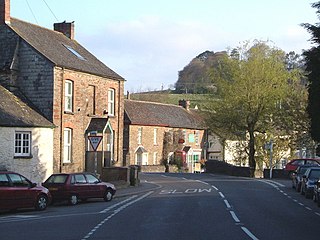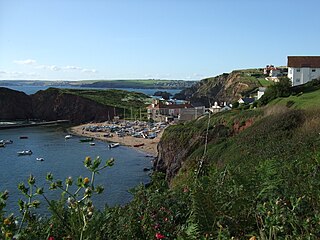
Kingsbridge is a market town and tourist hub in the South Hams district of Devon, England, with a population of 6,116 at the 2011 census. Two electoral wards bear the name of Kingsbridge. Their combined population at the above census was 4,381. It is situated at the northern end of the Kingsbridge Estuary, a ria that extends to the sea six miles south of the town. It is the third largest settlement in the South Hams.

South Hams is a local government district on the south coast of Devon, England. It is administered partly by South Hams District Council, which has its headquarters in the town of Totnes, and partly by Devon County Council in the nearby city of Exeter. The area also contains the towns of Dartmouth, Kingsbridge, Salcombe and Ivybridge, the last of which is the largest, with a population of 11,851.
A combe can refer either to a steep, narrow valley, or to a small valley or large hollow on the side of a hill; in any case, it is often understood simply to mean a small valley through which a watercourse does not run. The word "combe" derives from Old English cumb, of the same meaning, and is unrelated to the English word "comb". It derives ultimately from the same Brythonic source as the Welsh cwm, which has the same meaning. Today, the word is used mostly in reference to the combes of southern
and southwestern England, of Wales, and of County Kerry in Ireland.

The Kingsbridge Estuary in the South Hams area of Devon, England runs from Kingsbridge in the north to its mouth at the English Channel near Salcombe and lies between Bolt Head and Sharpitor to the west and Portlemouth Down to the east. The estuary is some 8.6 kilometres (5.3 mi) in length, with numerous side channels. Several of its creeks have independent names, including Blanksmill, Frogmore, Southpool, Batson and Bowcombe Creek.

South Pool is a village, parish and former manor in South Devon, England. It is situated 3 1/2 miles south-east of the town of Kingsbridge and 2 1/2 miles north-east of Salcombe. It is administered by the South Hams local authority. Historically it formed part of Coleridge Hundred. It falls within Woodleigh Deanery for ecclesiastical purposes.
The village is in an area of outstanding natural beauty at the head of South Pool creek.

Totnes is a constituency represented in the House of Commons of the UK Parliament since 2010 by Sarah Wollaston
of the Conservative Party.

Thurlestone is a village five miles (8 km) west of Kingsbridge in the South Hams district in south Devon, England. There is an electoral ward in the same name. The population at the 2011 census was 1,886.

The A381 road is a non-trunk 'A'-class road in Devon, England which serves as an important link between the towns of Teignmouth, Kingsteignton, Newton Abbot, Totnes and Salcombe and many villages in between, with the busiest section having 6 lanes and carrying an average of over 40,000 vehicles per day. The route overlaps with other A-roads for several sections of its length. It is a faster route from Teignmouth to Salcombe than the A379 which meets it at both ends. It is under the control of Devon County Council as highway authority.

Hope Cove is a small seaside village within the civil parish of South Huish in South Hams District, Devon, England. It is located some 5 miles (8.0 km) west of Salcombe and 5 miles (8.0 km) south west of Kingsbridge. It has two beaches, and is sheltered by the headland of Bolt Tail.

Salcombe Regis is a coastal village in Devon, England, near Sidmouth. Mentioned in the Domesday Book as "a manor called Selcoma" held by Osbern FitzOsbern, bishop of Exeter, the manor house stood on the site now occupied by Thorn Farm. The thorn tree growing in an enclosure at the road junction above the farm marked the cultivation boundary between manor and common ground.

The term Salcombe Yawl refers to a small sailing dinghy restricted class native to Salcombe in South Devon, and also to the traditional sailing vessel from the area upon which that class was based, with a 200-year history. The current class of vessel has about the size of a Merlin Rocket, that is 4.88 metres (16.0 ft) and about 180 have been built of which 80% are still in use. It is built traditionally by hand from mahogany, and is clinker built. The centre plate is cast iron, but more recent Yawls have bronze plates. While it is rigged as a ketch with the mizzen ahead of the rudder post, the label yawl is probably derived from a corruption of the word yole, meaning a small inshore fishing boat. Designers, work within the class restrictions, adding innovations to each vessel. It is raced in two classes depending on the age of the boat. A newly built boat in 2009 would cost £40,000 while a second hand vessel would be half of that. There is a glassfibre derivative with aluminium spars called a Devon Yawl. The mould for this was taken from a 1968 Salcombe Yawl and because of the nature of its construction is a one-design. There are approximately 300 Devon Yawls and they are built both in the UK and USA.
Kingsbridge branch line was a single track branch line railway in Devon, England. The line, which became known as the Primrose Line, opened in 1893 and despite local opposition closed in 1963. It left the Exeter to Plymouth line at Brent and ran 12 miles (19 km), following the route of the River Avon to Kingsbridge. A proposed extension to Salcombe was not constructed.

Dart Lifeboat Station is the base for Royal National Lifeboat Institution (RNLI) search and rescue operations at Dartmouth, Devon in England. The present station was opened in 2007 although an earlier lifeboat was stationed in the town from 1878 to 1896. It operates a D class (IB1) inshore lifeboat (ILB).

Salcombe Lifeboat Station is the base for Royal National Lifeboat Institution (RNLI) search and rescue operations at Salcombe, Devon in England. The first lifeboat was stationed in the town in 1869. The Salcombe Lifeboat has twice capsized, in 1916 with the loss of 13 lives, and in 1983 with no loss of life. Since 2008 the station has operated a Tamar-class all weather boat (ALB) and an Atlantic 75 inshore lifeboat (ILB).
South Devon is the southern part of Devon, England. Because Devon has its major population centres on its two coasts, the county is divided informally into North Devon and South Devon. In a narrower sense "South Devon" is used to refer to the part of Devon south of Exeter and Dartmoor, including Plymouth, Torbay and the districts of South Hams, West Devon and Teignbridge.
Tribute Devon 1, as the league is known for sponsorship reasons, is an English level nine, rugby union league for clubs based in Devon. The champions are promoted to Tribute Cornwall/Devon and the runner-up, plays the second team from Tribute Cornwall 1, with the winning team gaining promotion. Up until the end of the 2017-18 season, teams were relegated to Tribute Devon 2 but since that league has been abolished there is currently no relegation.

Hope Cove Life Boat was formed in 1878 and is a voluntary search and rescue service that operates an inshore rescue boat in the Bigbury Bay area.

Galmpton is a small hamlet near Thurlestone, Devon, England. It is in the South Hams district and is five miles west of Salcombe. In 1870-72 Galmpton had a population of 176 as recoded in the Imperial Gazetteer of England and Wales. Galmpton was recorded in the Domesday Book as Walementone/Walenimtona















